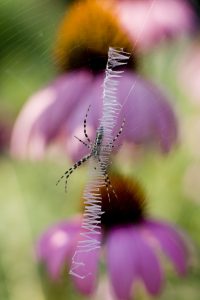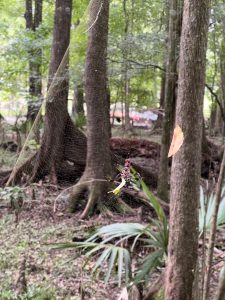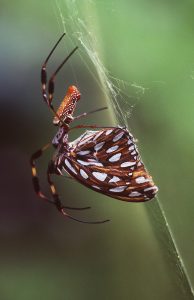
While 8-legged critters often spook people, my son has a soft spot for spiders. Years ago, he discovered one while in the shower, covered it with a cup to protect it from the threat of the drain, and released it safely outdoors. On a recent family hike through a state park, we noticed dozens of huge spiders with webs strung between branches, cypress knees, and fences along the edge of the trail. Sometimes known colloquially as banana spiders, we were seeing large orb weavers. They spin huge webs—several were 3-5’ in diameter. Each web contained a characteristic “zipper” pattern, called stabilimenta, in the middle that is reinforced with extra silk.

They are particularly fastidious about their hard-woven webs, too. While stopping to take photos, we noticed one spider had a couple of leaves that had fallen and lodged in the web. Apparently, the leaves were taking up valuable real estate that could be used to capture prey. We were astounded to watch her walk up to the leaves and start strategically snipping out sections of web around the edges of the leaf. She diligently moved around until the leaf loosened and fell away from the web and to the ground. After a quick repair job, she hurried on to another leaf did the same thing. We were completely captivated by this behavior—none of us had ever seen anything like it.

These spiders will also rebuild their webs daily. Two nights in a row a few summers back, we had a spider that built a web across our entire driveway, as if it were trying to trap us or our car as we entered the garage! Females will eat their old webs during the daytime then spin a new web each evening. Even these large webs only take about an hour to create.

Orb weavers account for 25% of all spider species worldwide and come in an incredible diversity of colors and body patterns. The “banana” spider refers to several that are bright yellow, while I’ve seen them in patterns of red, orange, green, and black. These colors often serve to reflect sunlight and cool their bodies, as they are common to temperate and tropical habitats.
The big spiders you see on these webs are always female. Males are tiny, tiny—often a tenth of the size of females. They show up this time of year, as the females are fertile in late summer. Females lay eggs in sacs that contain about 1,000 eggs. Orb weavers typically live for about a year.
Like bats and snakes, spiders get a bad rap. I totally get it—all the eyes, the long bendy legs, the bites—they can give folks the creeps. But like bats and snakes, they serve such an important role in the ecosystem, as insect control and as a food source for birds, larger insects, and lizards.
 10
10
